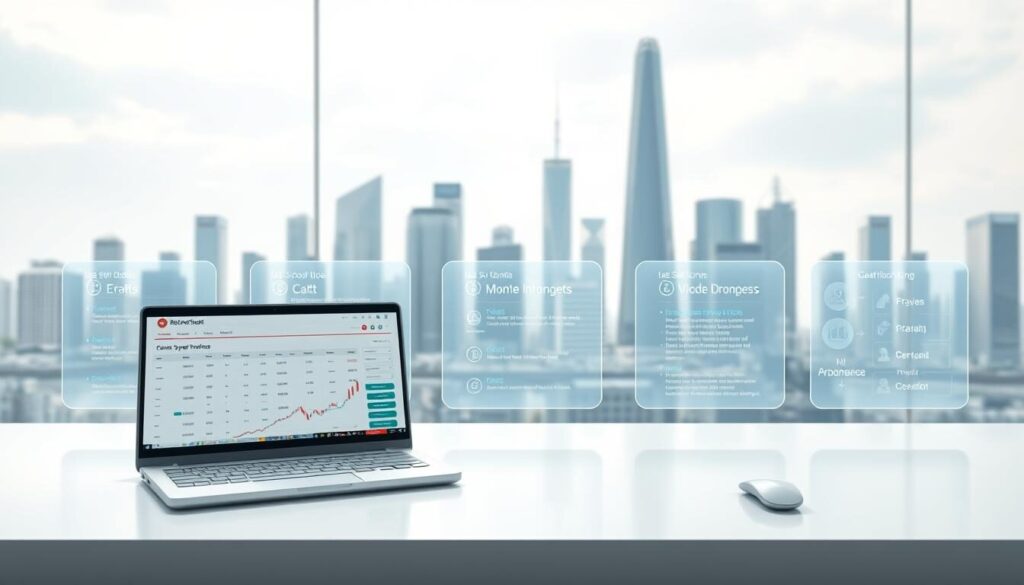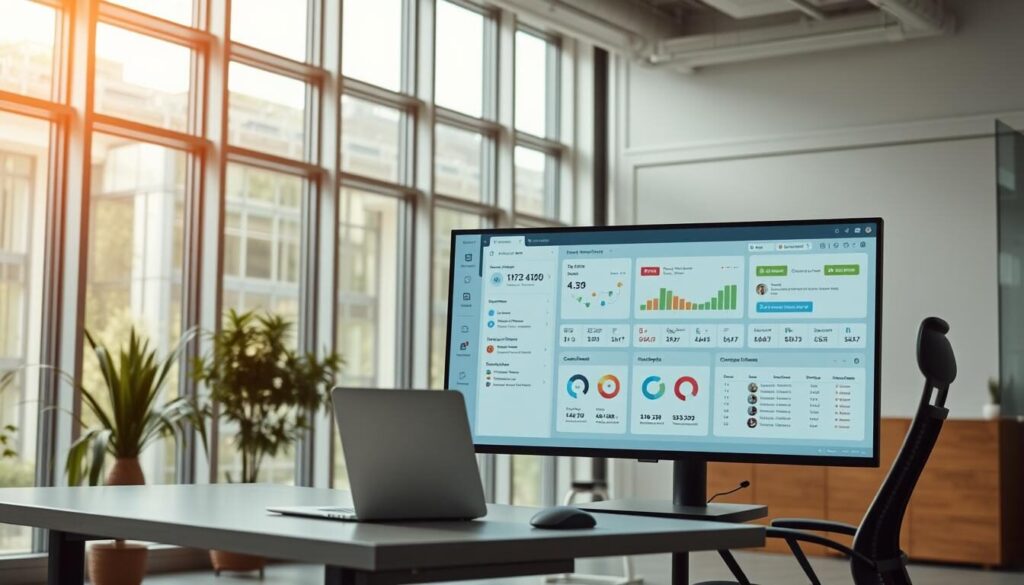Did you know the global forex market sees over $7.5 trillion traded daily? That’s like every person on Earth swapping $1,000—every. Single. Day. But here’s the kicker: launching a brokerage to tap into this isn’t just for Wall Street pros. Think of it as untangling a set of headphone wires—frustrating at first, but totally doable with the right steps.
Whether you’re a newbie or a trading veteran, this guide cuts through the jargon. We’ll explore models like white-label solutions (think renting a fully-built café vs. starting one from scratch) and break down what it takes to navigate regulations without losing your sanity. Spoiler: It’s less “Wolf of Wall Street” and more “strategic chess game.”
Why now? The demand for transparent, user-friendly platforms is skyrocketing. Modern traders want speed, security, and interfaces that don’t look like they’re from 2003. But here’s a secret: It’s not just about the money—it’s about solving puzzles. How do you balance compliance with innovation? Where do liquidity providers fit in? (Hint: They’re the backstage crew at a concert.)
Key Takeaways
- The forex market’s massive daily volume creates prime opportunities for new brokerages.
- Three main models exist: introducing broker partnerships, white-label platforms, and custom-built solutions.
- Regulatory compliance is non-negotiable—jurisdiction choices impact costs and credibility.
- Modern traders prioritize technology that’s both powerful and easy to navigate.
- Profitability hinges on strategic planning, not just market knowledge.
Ready to dive deeper? Let’s unpack the roadmap—no finance PhD required.
Introduction to the Forex Brokerage Landscape
Imagine every star in the Milky Way—then multiply by three. That’s roughly how many transactions zip through the forex market daily. Unlike stock exchanges with opening bells, this global party never stops. Tokyo sleeps? London’s sipping tea. New York logs off? Sydney’s already crunching numbers. It’s like a 24/7 concert where currencies are the headliners.
Why does this matter for brokerages? Simple: liquidity. With $7.5 trillion changing hands daily, there’s always someone to dance with. But here’s the twist—modern traders aren’t just chasing profits. They want platforms that feel like their favorite apps: slick, fast, and packed with real-time trading data. Think TikTok meets Wall Street.
The UAE alone hosts 300+ brokerages—a gold rush fueled by tech advancements. MetaTrader 5 dominates, but innovation’s the real MVP. Traders now expect AI-driven insights and zero lag. Miss a beat? They’ll swipe left faster than you can say “spread.”
What makes this market unique? No physical exchange floors. It’s all digital highways connecting banks, hedge funds, and grandma’s retirement account. Your brokerage isn’t just a middleman—it’s the DJ curating the experience. Get the playlist right (reliable information, tight spreads), and the crowd stays.
Ready to see how different business models tackle this chaos? Let’s explore your backstage pass options.
Understanding Forex Brokerage Business Models

Choosing a brokerage model is like picking a vehicle: some want plug-and-play scooters, others crave custom-built race cars. Each path offers unique trade-offs between speed, control, and upfront costs. Let’s break down the three main routes—and why hybrid approaches are gaining traction.
Introducing Broker: The Affiliate Highway
Think of introducing brokers (IBs) as ride-share drivers. You partner with established platforms, directing clients to their infrastructure. Pros? Near-zero startup costs and instant market access. Cons? You’re renting someone else’s car—limited branding and profit splits. Perfect for those testing brokerage waters.
White-Label Solutions: The Franchise Model
Ever seen a food truck with a famous chef’s logo? That’s white-label brokerage. You rebrand a pre-built platform—liquidity providers, tech stack, and all. Launch in weeks, not years. One client doubled their user base using B2BROKER’s white-label tools while keeping 85% profits. But remember: customization caps exist.
From Scratch: Building Your Batmobile
Want total creative control? Building your own platform lets you design every feature. Expect 6-18 months development and six-figure budgets. One startup spent $300k upfront but now dominates niche algorithmic trading. High risk, higher reward—if you’ve got the resources.
| Model | Cost | Time | Control |
|---|---|---|---|
| Introducing Broker | $1k-$5k | 2-4 weeks | Low |
| White-Label | $20k-$50k | 3-12 weeks | Medium |
| Custom Build | $100k+ | 6-18 months | Total |
| Hybrid | $30k-$80k | 2-6 months | High |
Hybrid models? They’re the Swiss Army knives—mixing IB partnerships with proprietary tools. One brokerage uses white-label core tech but added AI risk management. Result? 40% higher client retention. Your move depends on budget, appetite for complexity, and whether you’d rather drive or build the engine.
How to Start Your Own Forex Brokerage
Building a brokerage? Think of it like running a food truck. You need permits (legal stuff), a menu (products), and a prime parking spot (market positioning). Let’s unpack the recipe—no food poisoning guaranteed.
Step-by-Step Roadmap
1. Market Recon: Scope competitors like a secret shopper. Where are spreads stale? Which platforms feel like dial-up internet? One founder discovered 68% of traders crave mobile-first tools—golden intel.
2. Legal Groundwork: Pick jurisdictions like kitchen locations. Offshore = lower rent (fees). Established hubs = foot traffic (credibility). Pro tip: Cyprus costs 40% less than London for licensing.
3. Tech Stack: White-label platforms are pre-built food trucks. MT5’s the Mercedes, but maybe you need a vegan taco twist (custom indicators). Budget $15k-$50k here.
4. Partner Auditions: Liquidity providers are your ingredient suppliers. Test their spreads—slippage-free execution is the secret sauce. One broker axed their first provider after 72hrs of latency.
Key Considerations Before Launch
Budget Realities: Underestimating costs? That’s forgetting fuel for your food truck. Allocate 30% extra for regulatory speed bumps. Example: Malta’s $730k capital requirement blindsides many.
Team Chemistry: Hire a mix—tech geeks, compliance nerds, client whisperers. A Dubai-based firm does weekly “panic meetings” to air concerns. Smart.
Feedback Loops: Soft-launch with 100 beta testers. Fix leaks before grand opening. One team found 73% of client dropouts occurred during deposit processes—fixed in 48hrs.
Your playbook’s not set in stone. Markets shift. Tech evolves. Stay nimble—pivot when traders scream “menu change!” This isn’t a sprint; it’s a street food marathon with Michelin ambitions.
Regulatory Compliance and Licensing Options

Think of licenses as your brokerage’s passport—without one, you’re grounded. Compliance isn’t just red tape; it’s the foundation traders trust. Skip it? You might as well sell sushi from a food truck with no health permits.
Choosing a Jurisdiction
Picking where to register is like choosing a gym membership. Vanuatu’s the budget 24-hour spot ($50k capital, 3-month approval). The UK’s the luxury club—$100k upfront and year-long waits for FCA approval. Cyprus? The sweet spot: EU credibility at 40% lower costs than London.
Offshore hubs (Cayman Islands, Vanuatu) offer speed and lower fees. But remember: A Vanuatu license won’t impress Wall Street veterans. One startup used it as a testing ground before upgrading to CySec—like renting before buying a penthouse.
Navigating Licensing Requirements
The paperwork marathon includes:
- Proving financial stability (show them the money)
- KYC/AML systems tighter than airport security
- Office setup—virtual or physical
Budget $18k-$730k depending on location. Vanuatu’s turnkey package covers basics; the FCA demands Michelin-star compliance chefs. Pro tip: Allocate 30% extra for surprise fees—regulatory audits love curveballs.
Your license choice impacts everything from client trust to banking partnerships. Get it right, and you’re not just legal—you’re credible. Next up: Building tech that keeps up with your shiny new credentials.
Developing a Robust Trading Platform and IT Infrastructure

Your trading platform isn’t just software—it’s the beating heart of your operation. Like a Formula 1 engine, it needs raw power (processing speed), precision (reliability), and the ability to handle hairpin turns (market volatility) without sputtering. Get this right, and traders will feel like they’re driving a Ferrari. Get it wrong? Hello, roadside breakdowns.
Essential Platform Features
Modern traders want their platforms to work like their favorite apps: instant and intuitive. Must-haves include:
- Real-time execution (think sub-8ms speed)
- Military-grade security (hackers love forex like seagulls love fries)
- Customizable dashboards (let users choose their cockpit layout)
DXtrade CFD platforms show how it’s done—mobile sync lets traders switch devices mid-stride. One user placed orders from a ski lift. True story.
Integrating Third-Party Solutions
Your platform’s only as strong as its connections. Payment gateways? The toll roads moving money. Market data feeds? The GPS guiding decisions. Choose partners like you’d pick a co-pilot: proven reliability.
| Integration | Must-Haves | Cost Impact |
|---|---|---|
| Liquidity Hubs | Multi-source aggregation | 15-30% of budget |
| Chatbots | 24/7 multilingual support | $5k-$20k/year |
| Risk Tools | Auto-liquidation triggers | Built into most platforms |
Scalability’s the secret sauce. A well-designed trading infrastructure grows with you—like adding turbochargers to your engine. Future-proof tip: Demand API flexibility. Tomorrow’s tech shouldn’t require rebuilding from scratch.
Security can’t be an afterthought. Encryption? Non-negotiable. Regular audits? Like oil changes for your sports car. One breach could total your reputation faster than a meme stock crash.
Choosing your tech stack? Test drive multiple options. Ask: “Will this system handle Black Friday-level traffic on a random Tuesday?” Your platform’s not just a tool—it’s the track where your traders race. Build it to win.
Implementing Back Office and CRM Solutions

Think of your back office as air traffic control—quietly coordinating client journeys while your trading platform shines like the main stage. Modern systems here aren’t just spreadsheets on steroids. They’re the digital glue holding compliance, onboarding, and support together. Get this right, and traders feel like VIPs. Miss a beat? Cue the chaos.
Optimizing Client Management
A robust CRM isn’t a luxury—it’s your 24/7 client concierge. Picture it as a Swiss Army knife handling:
- Onboarding: Automated KYC checks that work faster than a barista during rush hour
- Data sync: Real-time updates across trading history, documents, and support tickets
- Compliance: Alerts for expiring IDs like a calendar app on steroids
Platforms like UpTrader show how it’s done. Their client portals let users track deposits, swap rates, and margin calls in one dashboard. One brokerage slashed onboarding time from 48 hours to 20 minutes using Skale CRM’s automation. That’s the power of integrated systems.
Why does this matter? Manual processes bleed time. Imagine staff drowning in PDF uploads while traders wait. Automation handles the grunt work—freeing your team to solve actual puzzles. Like why Mr. Smith keeps trading during lunch breaks. (Spoiler: He’s a night-shift nurse.)
| Feature | Client Impact | Broker Benefit |
|---|---|---|
| Mobile KYC | 5-minute signups | 75% fewer dropouts |
| AI Support Chat | Instant answers | 40% less ticket volume |
| Custom Reports | Transparent tracking | Faster audits |
Choose solutions that grow with you. Modular CRMs let you add features like Lego blocks—start with basics, then layer on AI risk alerts or multi-language support. Pro tip: Test-drive systems using real client scenarios. Can it handle a surge during Fed announcements? Your CRM should.
Ready for the next backstage pass? Let’s explore how liquidity partners and payment gateways keep the money flowing.
Securing Liquidity Providers and Payment Solutions

Liquidity providers are your brokerage’s oxygen—without them, trades suffocate. These financial powerhouses ensure clients never face “out of stock” moments during volatile markets. But choosing them isn’t like swiping right on Tinder. It’s strategic matchmaking where spreads, speed, and reliability determine your platform’s heartbeat.
Finding Your Market’s Pulse
Tier-1 liquidity providers act like wholesale suppliers—they offer deep pools of assets through ECN/STP networks. One broker using UpTrader’s multi-asset feeds saw spreads tighten by 38%. But smaller firms? Partnering with nimble Tier 3 providers can be smarter. Think of it as choosing between Costco bulk buys or local farm freshness.
Money Highways Need Toll Booths
Payment gateways are the toll roads moving cash. Credit cards work like express lanes—instant deposits but higher fees. E-wallets? The carpool lane: eco-friendly (lower costs) but limited to certain users. Bank transfers? Reliable semis hauling larger sums slowly.
| Method | Speed | Cost |
|---|---|---|
| Credit Cards | Instant | 2.9% + $0.30 |
| E-Wallets | 1.5%-2.5% | |
| Bank Transfers | 2-5 days | Flat $25 |
AlphaPoint’s blockchain integrations show the future: processing 5,000 transactions/sec with FATF-compliant tracking. Security here isn’t optional—it’s the guardrails preventing financial pileups. Get this right, and traders trust you with their life’s savings. Get it wrong? Let’s not go there.
Risk Management and Trade Execution Models
Managing trades is like coaching a football team—you need playbooks that adapt to every opponent. Execution models determine whether you’re passing risks to others or tackling them head-on. Let’s break down the game plans smart brokerages use to stay in the black.
A-Book: The Matchmaking Service
Imagine Tinder for trades. A-Book models connect client orders directly to liquidity providers—no middleman drama. Your brokerage earns commissions, not profits from losses. It’s risk-free but relies on others’ reliability. One platform using STP execution saw 92% trade success rates. Traders love the transparency; you’ll love predictable income.
B-Book: The House Party
Here, your brokerage becomes the host—and the dealer. You keep trades in-house, profiting when clients lose. Risky? Absolutely. Like betting against your own team. One firm lost $2 million during a surprise Fed rate hike. But when markets calm, profits can soar. Just don’t get caught cheering against your guests.
| Model | Risk | Profit Source | Best For |
|---|---|---|---|
| A-Book | Low | Commissions | New brokers |
| B-Book | High | Client losses | Volatile markets |
| Hybrid | Medium | Both | Balanced growth |
Hybrid Models: The Buffet Approach
Why choose one dish? Hybrid strategies route some trades externally, others internally. It’s like having insurance while skydiving—you’re covered if the chute fails. A Cyprus-based firm routes 60% of trades to LPs, keeping 40% in-house. Result? 28% higher profits than pure models. Traders get speed; you get stability.
Real-time monitoring tools act like weather radars—spotting storms before they hit. Agile tech adjusts execution based on market moods. Remember: No strategy survives first contact with a Brexit-level event. Stay nimble, stay solvent.
Target Audience Identification and Market Positioning
Picture this: You’re throwing a party. Do you blast death metal for yoga instructors? Serve kale smoothies at a barbecue? Nailing your target audience is like knowing your guests’ tastes before they RSVP. In forex’s crowded market, generic invites get lost in the noise.
Tailoring Services to Trader Needs
Start by stalking—ethically. Scrape social media for trader gripes (“Why do platforms hate mobile users?”). Analyze heatmaps showing where users rage-click. One brokerage discovered 68% of their audience traded during commutes. Result? A subway-friendly app with one-thumb navigation.
Positioning is everything. Are you the luxury sports car or the reliable minivan? High-volume pros want raw speed: ECN accounts, API access. Newbies crave training wheels: demo accounts, comparison tools. One firm tailored spreads for night owls in New Zealand—their retention rate doubled.
“But how do I stand out?” Think tacos vs. pizza. Both feed people, but one’s messy fun. A Cyprus-based broker offers meme-based risk alerts (think “Doge coin vibes” for volatile pairs). Another uses Spotify-style playlists for market updates. Quirky? Yes. Memorable? Absolutely.
Feedback loops are your secret sauce. Track dropouts like a detective. Why did Sarah abandon her cart? Maybe KYC forms felt like tax audits. Tools like Hotjar reveal pain points faster than a toddler spills secrets.
Your move: Build customer personas sharper than a TikTok algorithm. The “Retiree Rick” needs stability; “Crypto Carla” craves volatility. Map their journeys from Google ads to withdrawal screens. Test. Tweak. Repeat.
Market positioning isn’t set-and-forget. It’s jazz improv—listen, adapt, surprise. Because in forex’s endless party, the best hosts know when to change the playlist.
Budgeting, Costs, and Financial Planning for Your Brokerage
Building a brokerage’s finances is like constructing a house—you need blueprints (budgets), quality materials (tech), and emergency exits (contingency funds). Let’s break down the math without the migraine.
Estimating Startup Expenses
Launching costs range from $20k to $300k+, depending on your model. White-label setups? Think $50k for licensing, platform fees, and basic marketing. Custom builds? Add another $200k for developers. Here’s the kicker: Cyprus licenses cost 40% less than London’s—a hack many new brokers miss.
- Licensing: $50k (Cyprus) vs. $730k (UK)
- Tech stack: $15k/month for MT5 integration
- Staffing: $8k/month for 3 specialists
Forecasting Long-Term Revenue
Income flows from spreads, commissions, and overnight fees. One brokerage earns $12k/month from 500 active traders. But markets shift—plan for rainy days. Pro tip: Allocate 30% of profits to a contingency fund. When Bitcoin crashed 20% in 2022, savvy firms leaned on these reserves.
| Jurisdiction | Cost | Approval Time | Min Capital |
|---|---|---|---|
| Cyprus | $50k | 6 months | $200k |
| Vanuatu | $20k | 3 months | $50k |
| UK | $730k | 12 months | $1.3M |
Scalability’s secret? Start lean. Use modular tech that grows with your client base. One firm doubled traders without increasing costs by using B2Broker’s bundled solutions. Remember: Financial planning isn’t about predicting the future—it’s about building shock absorbers for the ride.
Building a Talented Team and Setting Up Operations
Building a brokerage team feels like drafting players for the Super Bowl—every position needs precision. You wouldn’t hire a quarterback to play defense. Same rules apply here. Your company needs specialists who thrive under pressure, from compliance referees to tech wizards.
Roles That Score Touchdowns
Start with core positions:
- Compliance officers: The rulebook experts keeping penalties at bay
- IT ninjas: Code warriors preventing platform meltdowns
- Support stars: Crisis managers who calm frantic traders
One New York-based company uses “skill auditions”—candidates troubleshoot live tech issues during interviews. Harsh? Maybe. Effective? Their platform uptime hit 99.98%.
| Role | Must-Have Skills | Recruiting Hack |
|---|---|---|
| Sales Lead | Persuasion, market analysis | Test with mock client calls |
| Risk Manager | Data crunching, calm under fire | Simulate Black Swan events |
| Affiliate Manager | Networking, analytics | Role-play partnership pitches |
Training’s the secret sauce. Think weekly “Market Mondays” where teams dissect trends over coffee. One office in Chicago uses VR simulations for crisis scenarios—traders love it.
Location matters. A physical office boosts trust, but remote talent expands your playbook. Hybrid models let you draft global all-stars while keeping local flavor. Pro tip: Use tools like Trello for operations—track tasks like a fantasy league lineup.
Diversity isn’t just buzzword bingo. Teams mixing backgrounds solve problems faster. Ever seen a math whiz and a poet brainstorm risk alerts? Magic happens.
Keep your squad sharp with ongoing education. Webinars, certifications, even TikTok recaps of Fed meetings. Because in forex, yesterday’s strategies become today’s memes.
Leveraging Marketing Strategies and Branding Your Brokerage
Launching a brokerage without smart marketing is like throwing a concert without speakers—you’ve got the talent, but nobody hears it. Modern traders scroll faster than hummingbirds flap wings. Hook them in 3 seconds or lose them to cat videos.
Digital Marketing Tactics That Convert
Forget billboards. Today’s battle happens where traders live:
- SEO: Target phrases like “low-spread EUR/USD brokers” – one firm tripled traffic using Semrush’s gap analysis
- Social Proof: User-generated content outperforms ads by 300% – think client success TikToks with #TradeWins
- Affiliate Programs: Pay-for-performance partnerships – FXTM’s network drives 40% of new signups
| Channel | Cost per Lead | Conversion Rate |
|---|---|---|
| Google Ads | $18 | 2.1% |
| $32 | 4.7% | |
| Webinars | $7 | 8.9% |
Crafting Unforgettable Brand Identities
Your brand isn’t a logo—it’s the emotional aftertaste. Pepperstone nails this with their “Trade Beyond Ordinary” campaign featuring extreme athletes. Three ingredients for magnetic branding:
- Voice: Chatty expert (think Reddit AMA meets CNBC)
- Visuals: Color schemes that pop like trading alerts
- Values: 73% of traders choose brokers supporting financial literacy programs
Webinars with live Q&A sessions boost retention by 60%. Chatbots? They resolve 80% of FAQs while you sleep. Track everything—one tweaked email subject line increased opens by 217%.
Ready to become the industry’s Beyoncé? Start tuning your brand’s melody today. The charts await.
Conclusion
The path to launching a trading venture mirrors assembling a high-performance engine—every component matters. From selecting your business model to fine-tuning operations, each choice shapes your platform’s DNA. Compliance acts as the chassis, technology as the turbocharger, and marketing as the GPS guiding traders to your door.
Here’s the beautiful part: You’re not building in a vacuum. The market thrives on fresh solutions that balance security with innovation. Whether partnering with white-label providers or crafting custom tools, success hinges on marrying strategy with adaptability. Those spreadsheets on financial planning? They’re your roadmap through regulatory jungles.
Remember that coffee shop analogy earlier? Your brokerage’s the barista—consistency and personal touches keep clients returning. Build teams that geek out over risk algorithms and client onboarding. Prioritize learning loops: Markets evolve faster than TikTok trends.
Now’s your moment to shift from spectator to architect. Use this guide as your blueprint, revisit sections like cheat codes, and start small. One trade at a time, one client at a time. The process isn’t about perfection—it’s about progress with purpose.
Ready to rev your engines? The trading world’s waiting for your signature blend of grit and ingenuity. First step’s always the hardest. But as any seasoned trader knows—the best returns favor those who start.
